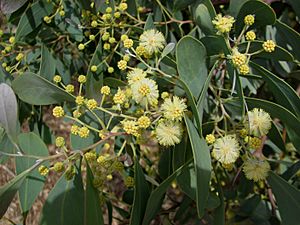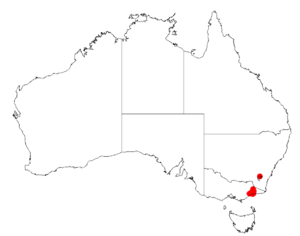Limestone blue wattle facts for kids
Quick facts for kids Limestone blue wattle |
|
|---|---|
 |
|
| Conservation status | |
| Scientific classification | |
| Genus: |
Acacia
|
| Species: |
caerulescens
|
 |
|
| Occurrence data from AVH | |
| Synonyms | |
|
Racosperma caerulescens (Maslin & Court) Pedley |
|
The Limestone Blue Wattle (Acacia caerulescens) is a special tree found only in a small part of southeastern Australia. It's also known as Buchan blue or Buchan blue wattle. This beautiful wattle tree is unique to its home country.
What the Limestone Blue Wattle Looks Like
This wattle tree can grow quite tall, usually between 10 to 15 meters (about 33 to 49 feet) high. It has a shape like a pyramid, wider at the bottom and narrower at the top. Its branches are smooth and don't have any hairs, and they often have a fine white powder on them.
Like most wattle trees (which are part of the Acacia family), the Limestone Blue Wattle doesn't have true leaves. Instead, it has what are called phyllodes. These are flattened leaf stems that act like leaves. The phyllodes of this wattle are always green. They are shaped like an upside-down egg or a narrow oval, and they are about 4 to 8 centimeters (1.5 to 3 inches) long and 1.5 to 3 millimeters (about 0.06 to 0.12 inches) wide.
In its natural home, you can see bright lemon-yellow, round flowerheads. These flowers grow in clusters called racemes and appear from November to December. After the flowers, the tree grows seed pods. These pods are about 5 to 12 centimeters (2 to 4.7 inches) long and 1.4 to 2.2 centimeters (0.5 to 0.9 inches) wide.
How This Wattle Got Its Name
Scientists officially described this tree species in 1989. They based their description on plants they found near a place called Buchan in Gippsland, Australia. This is how the tree got its scientific name, Acacia caerulescens, and its common names like Buchan blue wattle.
Where the Limestone Blue Wattle Grows
The Limestone Blue Wattle has a very limited home. It is only found in a small area of Victoria, Australia. You can mostly find it near Lakes Entrance and Buchan.
This wattle tree prefers to grow in clay soils that are found over limestone rock. It is often seen as part of natural forests where Eucalyptus trees also grow. Sadly, the places where this wattle naturally lives are shrinking because of land clearing for other uses. This makes it important to protect these special trees and their habitats.


